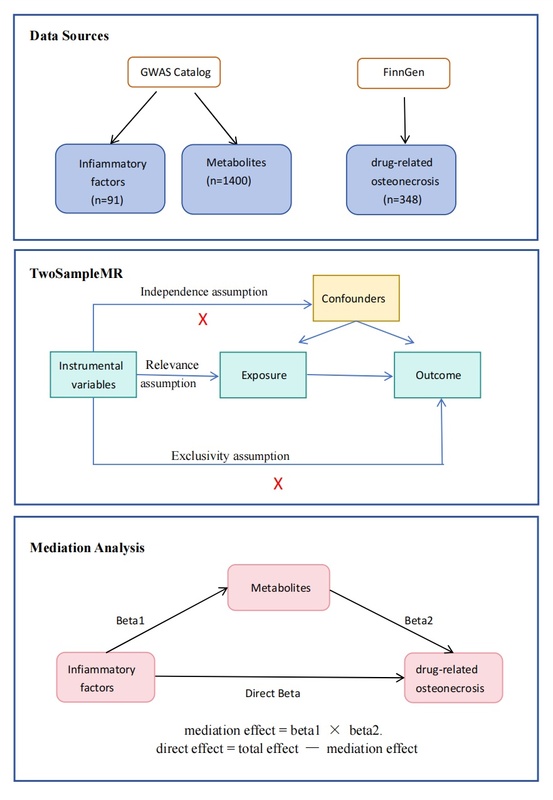Current issue
Archive
Manuscripts accepted
About the Journal
Editorial office
Editorial board
Section Editors
Abstracting and indexing
Subscription
Contact
Ethical standards and procedures
Most read articles
Instructions for authors
Article Processing Charge (APC)
Regulations of paying article processing charge (APC)
ORTHOPEDICS AND TRAUMATOLOGY / RESEARCH PAPER
Research based on nucleotide polymorphism reveals the role of inflammatory cytokines in regulating the influence of blood metabolites on drug-related osteonecrosis.
1
Clinical Medical College of Hebei University of Engineering, China
2
Institute of Orthopedics, The Fourth Medical Center of Chinese PLA General Hospital, Beijing Key Lab of Regenerative Medicine in Orthopedics, Key Laboratory of Musculoskeletal Trauma & War Injuries PLA, China
Submission date: 2024-11-22
Final revision date: 2025-01-27
Acceptance date: 2025-01-31
Online publication date: 2025-04-20
Corresponding author
Jiang Peng
Clinical Medical College of Hebei University of Engineering, No.81,Congtai Road, 056000, Handan, China
Clinical Medical College of Hebei University of Engineering, No.81,Congtai Road, 056000, Handan, China
KEYWORDS
nucleotide polymorphismpro-inflammatory mediatorsmetabolitesdrug-related osteonecrosisMendelian randomization
TOPICS
ABSTRACT
Introduction:
Osteonecrosis is a debilitating disease caused by impaired blood supply leading to bone tissue death, and drug-related osteonecrosis is a significant clinical issue.The role of inflammation and metabolic disorders in the pathogenesis of osteonecrosis has garnered widespread attention, but the exact causal relationships remain unclear.This study aims to explore the causal link between inflammatory cytokines and drug-related osteonecrosis, while also investigating how metabolites might mediate this relationship.
Material and methods:
We employed two-sample Mendelian randomization (MR) analysis to examine the causal links between 91 inflammatory cytokines, 1,400 blood metabolites, and drug-related osteonecrosis.Single nucleotide polymorphisms (SNPs) associated with inflammatory cytokines and metabolites were used as instrumental variables (IVs) to assess their potential relationship with drug-related osteonecrosis risk.We further conducted mediation MR analysis to explore the role of metabolites in mediating the impact of inflammatory cytokines on drug-related osteonecrosis.
Results:
MR analysis demonstrated notable causal relationships between four inflammatory cytokines and drug-related osteonecrosis.Specifically, Interleukin-4 (IL-4) and C-X-C motif chemokine 6 (CXCL6) showed a negative correlation with the risk of drug-related osteonecrosis, while Interleukin-6 (IL-6) and Glial cell line-derived neurotrophic factor (GDNF) exhibited a positive correlation with the risk.Furthermore, mediation analysis revealed that IL-4 affects the development of drug-related osteonecrosis via blood metabolites. Key metabolites identified as significant mediators included mannitol/sorbitol levels, the mannose-to-mannitol-to-sorbitol ratio, and the glucose-to-mannitol-to-sorbitol ratio.
Conclusions:
This study presents new evidence connecting inflammatory cytokines to drug-related osteonecrosis and highlights the mediating role of metabolites.These results help us understand the pathogenesis of the disease and provide new insights for its prevention and treatment.
Osteonecrosis is a debilitating disease caused by impaired blood supply leading to bone tissue death, and drug-related osteonecrosis is a significant clinical issue.The role of inflammation and metabolic disorders in the pathogenesis of osteonecrosis has garnered widespread attention, but the exact causal relationships remain unclear.This study aims to explore the causal link between inflammatory cytokines and drug-related osteonecrosis, while also investigating how metabolites might mediate this relationship.
Material and methods:
We employed two-sample Mendelian randomization (MR) analysis to examine the causal links between 91 inflammatory cytokines, 1,400 blood metabolites, and drug-related osteonecrosis.Single nucleotide polymorphisms (SNPs) associated with inflammatory cytokines and metabolites were used as instrumental variables (IVs) to assess their potential relationship with drug-related osteonecrosis risk.We further conducted mediation MR analysis to explore the role of metabolites in mediating the impact of inflammatory cytokines on drug-related osteonecrosis.
Results:
MR analysis demonstrated notable causal relationships between four inflammatory cytokines and drug-related osteonecrosis.Specifically, Interleukin-4 (IL-4) and C-X-C motif chemokine 6 (CXCL6) showed a negative correlation with the risk of drug-related osteonecrosis, while Interleukin-6 (IL-6) and Glial cell line-derived neurotrophic factor (GDNF) exhibited a positive correlation with the risk.Furthermore, mediation analysis revealed that IL-4 affects the development of drug-related osteonecrosis via blood metabolites. Key metabolites identified as significant mediators included mannitol/sorbitol levels, the mannose-to-mannitol-to-sorbitol ratio, and the glucose-to-mannitol-to-sorbitol ratio.
Conclusions:
This study presents new evidence connecting inflammatory cytokines to drug-related osteonecrosis and highlights the mediating role of metabolites.These results help us understand the pathogenesis of the disease and provide new insights for its prevention and treatment.
Share
RELATED ARTICLE
We process personal data collected when visiting the website. The function of obtaining information about users and their behavior is carried out by voluntarily entered information in forms and saving cookies in end devices. Data, including cookies, are used to provide services, improve the user experience and to analyze the traffic in accordance with the Privacy policy. Data are also collected and processed by Google Analytics tool (more).
You can change cookies settings in your browser. Restricted use of cookies in the browser configuration may affect some functionalities of the website.
You can change cookies settings in your browser. Restricted use of cookies in the browser configuration may affect some functionalities of the website.



